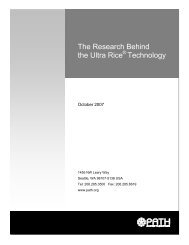How Vaccines Work - PATH
How Vaccines Work - PATH
How Vaccines Work - PATH
You also want an ePaper? Increase the reach of your titles
YUMPU automatically turns print PDFs into web optimized ePapers that Google loves.
6 NPI REFERENCE GUIDE ON VACCINES AND VACCINE SAFETY<br />
we are exposed to any single agent, that is, even if we are exposed<br />
to a single agent many times, our response to each exposure is<br />
the same.<br />
Acquired Immunity – Antibody Response<br />
Induction of a specific, protective immune response, i.e.,<br />
acquired immunity, enhances the natural response by directing<br />
certain interactions among the cells participating in the immune<br />
response. Conditions for these interactions are met when the<br />
number of pathogens is large or persistent, or when they are not<br />
readily eliminated by the natural mechanisms.<br />
(1) (2) (3) (4)<br />
(1) A macrophage in the presence of an infectious agent<br />
(2) The macrophage engulfs and breaks down the infectious agent into<br />
small fragments<br />
(3) The fragments bind to MHC Class II molecules that are produced by<br />
the macrophage<br />
(4) Complexes of antigen fragments and MHC Class II molecules are<br />
transported to the macrophage surface<br />
Macrophages play a critical role in the establishment of specific<br />
acquired immunity. 2, 3 As macrophages engulf an infectious<br />
organism or a certain vaccine, it is broken down chemically into<br />
constituent proteins and other biochemical components. The<br />
proteins are further degraded and the resulting small fragments<br />
of protein associate with certain molecules, known as major<br />
histocompatibility complex (MHC) Class II molecules, that are<br />
produced by the macrophages. These complexes, consisting of<br />
the protein fragment or antigen and the MHC Class II molecule,<br />
are arrayed on the surface of the macrophage where the<br />
8, 9<br />
antigen can be “presented” to certain lymphocytes.<br />
(1) (2) (3) (4)<br />
(1) B cell in the presence of an infectious agent<br />
(2) Receptors on the B cell adhere to the infectious agent<br />
(3) The now activated B cell divides to produce many virtually identical<br />
copies of itself<br />
(4) The B cells mature into plasma cells that release antibodies that can<br />
adhere to the infectious agent, leading to its destruction<br />
HOW VACCINES WORK<br />
Lymphocytes, specifically B lymphocytes (or B cells) and T<br />
lymphocytes (or T cells), mediate protective immunity. Both<br />
types of cells circulate freely in the blood and large numbers<br />
reside in the spleen, lymph nodes and other tissues where antigen<br />
exposure is likely. B cells have structures on their surface<br />
membranes known as receptors that simultaneously recognize<br />
and adhere to proteins that make up the pathogen or vaccine.<br />
This contact is sufficient to activate the B cell causing it to<br />
divide rapidly, forming hundreds if not thousands of virtually<br />
identical cells. Many of the B cells ultimately mature into plasma<br />
cells, all of which release large amounts of antibody molecules<br />
that can specifically attack the pathogen.<br />
(2)<br />
(1)<br />
(1) Macrophages, B cells and T cells are attracted to the site of an infection<br />
(2) The macrophage engulfs the agent and presents fragments to helper T cells<br />
(3) Activated helper T cells release cytokines that promote B cell activity<br />
(4) Different B cells recognize different parts of the infectious agent<br />
(5) Each B cell matures into an antibody releasing plasma cell<br />
There are at least two distinct populations of T cells and<br />
these are distinguishable, in part, by the types of receptors found<br />
on their surfaces. The receptor on the helper T cell simultaneously<br />
recognizes and briefly adheres to the antigen and MHC<br />
Class II complex presented by macrophages or other antigen<br />
presenting cells; 8, 9 the other T cell population is discussed below.<br />
This contact, although transient, is sufficient to activate the lymphocyte<br />
causing it to release more or different cytokines. The<br />
cytokines stimulate cells, particularly antigen-stimulated B cells,<br />
to divide and become functionally mature. Because a pathogen<br />
or vaccine may have hundreds or thousands of distinct antigens,<br />
many different B cells are stimulated simultaneously.<br />
This results in the production and release of many different<br />
antibodies that recognize many of the distinct antigenic components<br />
of the pathogen. Antibody molecules encountering the<br />
pathogen attach to it, providing a handle by which macrophages,<br />
other cells or other types of molecules attach to the pathogen<br />
resulting in its destruction. In other cases, aggregations of many<br />
antibody-linked pathogens are eliminated in the urine or stool.<br />
Acquired Immunity – Cell-Mediated Response<br />
Antibody-mediated immunity is most effective when the<br />
pathogen occurs in the tissues and does not become established<br />
within individual cells. Other pathogens penetrate into individual<br />
cells where they can avoid interactions with antibodies and<br />
thus persist for long periods of time, causing acute or chronic<br />
disease. Viruses are particularly adept at this. When viruses<br />
(3)<br />
(4)<br />
(5)

















